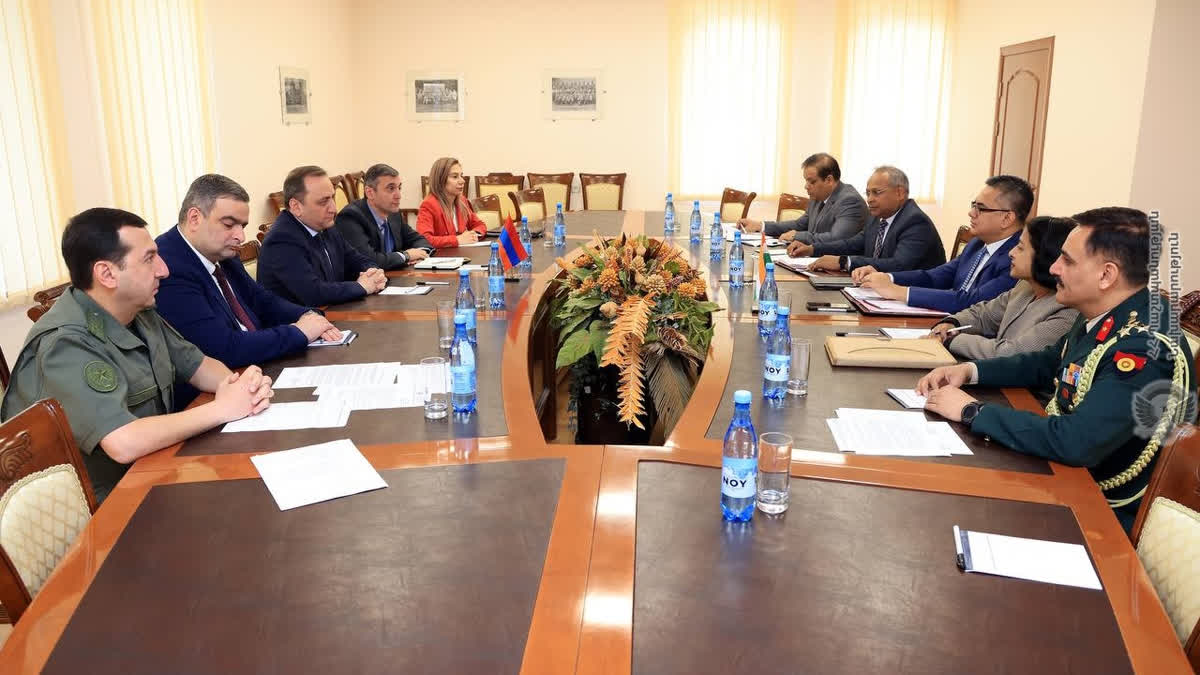New Delhi: A month after Russian forces started withdrawing from Azerbaijan’s Nagorno-Karabakh region, India held the first-ever defence consultations with the neighbouring Caucasian nation of Armenia. According to a statement issued by the Defence Ministry of Armenia following the consultations held in Yerevan on May 14, the Indian side was led by Joint Secretary for International Cooperation in the Ministry of Defence Vishwesh Negi while the Armenian side was led by the Head of the Department of Defence Policy and International Cooperation Levon Ayvazyan.
“During the consultations, the present state of cooperation between Armenia and India in the defence sector and prospects for future development, including military-technical, military education and combat training of personnel, exchange of experience and others, were discussed,” the statement read. “Additionally, the meeting addressed issues related to regional security. Levon Ayvazyan provided an overview of the ongoing reforms within the Armed Forces of the Republic of Armenia.”
According to the statement, a protocol on the results of the consultations was signed, which approved a cooperation plan between the defence ministries of India and Armenia for 2024-2025, and provided for the establishment of a joint working group on the issues of bilateral defence cooperation.
So, what is it that made India hold such consultations with Armenia?
According to Swasti Rao, Associate Fellow at the Manohar Parrikar Institute of Defence Studies and Analyses, India is one of the two major defence equipment suppliers to Armenia, the other being France.
“Armenia has allocated a budget of $1.5 million for defence equipment procurement,” Rao told ETV Bharat. “The meeting came a month after Russian peacekeeping troops started withdrawing from Azerbaijan’s Nagorno-Karabakh region.”
Armenia, she explained, is bitter with Russia for not supporting it in its territorial conflict with Azerbaijan over Nagorno Karabakh. Although Armenia is a part of the Collective Security Treaty Organisation (CSTO) of which Russia is also a member, Moscow did not come to the aid of Yerevan in its battle for Nagorno-Karabakh against Azerbaijan. Rao pointed out that Azerbaijan is not a member of the CSTO.
What is the CSTO?
Similar to NATO, CSTO is an intergovernmental military alliance in Eurasia consisting of six post-Soviet states. It originated from the Collective Security Treaty (CST), also known as the Tashkent Treaty, which was signed on May 15, 1992, by several former Soviet Republics: Armenia, Kazakhstan, Kyrgyzstan, Russia, Tajikistan, and Uzbekistan. The treaty came into force in 1994, aiming to maintain peace and stability in the post-Soviet space by providing a framework for mutual defence.
In 2002, the CST was transformed into the CSTO, formalising the alliance into a more structured organisation. The treaty stipulates that an act of aggression against one member state is considered an act of aggression against all members, obliging them to assist each other, including the use of armed force if necessary.
The CSTO remains a significant player in the security architecture of the Eurasian region. By providing a framework for collective defence and military cooperation, it contributes to the stability and security of its member states. Despite its challenges, the organisation continues to evolve and adapt to the changing geopolitical landscape, seeking to address both traditional and non-traditional security threats. As of 2024, the CSTO consists of six member states: Armenia, Belarus, Kazakhstan, Kyrgyzstan, Russia, and Tajikistan
What was the conflict between Armenia and Azerbaijan over Nagorno-Karabakh all about?
Armenia and Azerbaijan were involved in an ethnic and territorial conflict for over three decades over the disputed Nagorno-Karabakh, a region in the South Caucasus. In 1988, ethnic Armenians living in Nagorno-Karabakh demanded the transfer of what was then the Nagorno-Karabakh Autonomous Oblast from Soviet Azerbaijan to Armenia.
Following the collapse of the Soviet Union, these tensions grew into an outright war. In December 1991, the Armenians of Nagorno-Karabakh declared their independence as the Republic of Nagorno-Karabakh with the intention of reunifying with newly independent Armenia. The local Azerbaijanis were opposed to this.
The declaration was rejected by newly independent Azerbaijan, leading to the outbreak of full-scale war with Armenia and Nagorno-Karabakh on one side and Azerbaijan on the other. The First Nagorno-Karabakh War ended with a ceasefire in May 1994, with Armenian forces controlling practically the entire territory of the former Nagorno-Karabakh Autonomous Oblast as well as most of seven adjacent districts of Azerbaijan. The Republic of Artsakh, as it officially came to be known, became a de facto independent country, though closely integrated with Armenia, while its territory remained internationally recognised as part of the Republic of Azerbaijan.
However, intermittent fighting over the region continued after the 1994 ceasefire without significant territorial changes, while long-standing international mediation attempts to create a peace process were initiated by the Organisation for Security and Cooperation in Europe (OSCE) Minsk Group in 1994.
Then, in September 2020, fighting again erupted between Armenia and Azerbaijan over Artsakh, which, observers believe, may have claimed thousands of lives. Azerbaijan recaptured territories, primarily in the southern part of the region. A ceasefire agreement signed on November 10, 2020, between Armenia, Azerbaijan and Russia declared an end to the renewed fighting, and established that Armenia would withdraw from remaining occupied territories surrounding Nagorno-Karabakh over the next month. The agreement included provisions for a Russian peacekeeping force to be deployed in the region.
On September 19 last year, Azerbaijan launched a sudden military offensive. The very next day, the government of the Republic of Artsakh agreed to disarm, which led to a ceasefire. On September 28, Artsakh president Samvel Shahramanyan signed a decree stating that all state institutions would be dissolved by January 1, 2024, bringing the existence of the republic to an end.
What is India’s interest in Armenia?
India is concerned about Turkey’s imperial ambition of creating a pan-Turkic empire that will cover the Caucasus and parts of Eurasia. It envisions an empire that will comprise all nations and regions where a Turkic type of language is spoken. India has decided to oppose Azerbaijan and its allies, Pakistan and Turkey, and Turkey’s expansionist plans.
As an ally of Azerbaijan, Pakistan has supplied men and military to the Central Asian nation to assist in its conflicts. Azerbaijan has reciprocated by offering Pakistan geopolitical, geo-economic and geo-strategic benefits. The aim of seizing Armenian territory is to gain unhindered access forcibly to Turkey, Azerbaijan, Pakistan and other Turkic-oriented nations. At the same time, Turkey, Azerbaijan and Pakistan share a similar stance on Kashmir. While Turkey’s President Recep Tayyip Erdogan had sharply condemned India’s abrogation of Article 370 in Jammu and Kashmir in 2019, Azerbaijani officials have been quoted as saying that they support Islamabad’s stand on Kashmir. This is a cause of major diplomatic concern for New Delhi.
Another reason why India is backing Armenia is the International North-South Transport Corridor (INSTC) in which India has a major stake. The INSTC is a 7,200-km-long multi-modal network of ship, rail, and road routes for moving freight between India, Iran, Azerbaijan, Russia, Central Asia and Europe. The route primarily involves moving freight from India, Iran, Azerbaijan and Russia via ship, rail and road. Since the project is not making much progress, Armenia is being seen as a country that can provide a viable alternative corridor instead of through Azerbaijan.
“Though India has good ties with Azerbaijan too, New Delhi’s main concern is about that country falling in the axis of Turkey and Pakistan,” Rao said. At the same time, she stated that by entering into defence cooperation with Armenia, India has no intention of antagonising Russia.
“All India wants is peace and stability in the Caucasus,” she said.
So, what has India-Armenia defence cooperation been like?
In recent years, defence cooperation has emerged as a key pillar of India-Armenia relations. Last year, India struck a Rs 6,000-crore deal to export the indigenously developed Akash medium-range surface-to-air missile (SAM).
The Akash SAM system was developed by India’s Defence Research and Development Organisation (DRDO) and is produced by Hyderabad-based Bharat Dynamics Ltd (BDL). The Akash missile system can target aircraft up to 45 km away. It has the capability to neutralise aerial targets like fighter jets, cruise missiles and air-to-surface missiles as well as ballistic missiles. It is in operational service with the Indian Army and the Indian Air Force.
Apart from the Akash SAM system, New Delhi has engaged in significant military equipment sales to Yerevan. A notable instance occurred in March 2020 when Armenia, becoming the first international client, acquired the Indian Swathi radar system for $40 million. This system, a collaborative effort between the DRDO and Bharat Electronics Limited (BEL), represents the latest generation of phased array or electronically steered radars utilised by ground forces to detect and guide counter-battery fire against enemy ordnances.
Then again, in September 2022, a $245-million contract was signed for the Pinaka multi-barrel rocket launchers, anti-tank rockets, and various types of ammunition. India has key interests in boosting defence cooperation with Armenia. Over the last few years, the India-Armenia relationship has become very prominent because of a strategic angle. Armenia, it may be mentioned was attacked by Azerbaijan and Azerbaijan is supported by Pakistan and Turkey.
It is worth mentioning here that India went ahead with the defence consultations with Armenia even after Azerbaijan warned New Delhi last month against supplying defence hardware to the neighbouring Caucasian Asian country.
Read more: India-Iran-Armenia Trade Corridor On The Cards: The Importance



